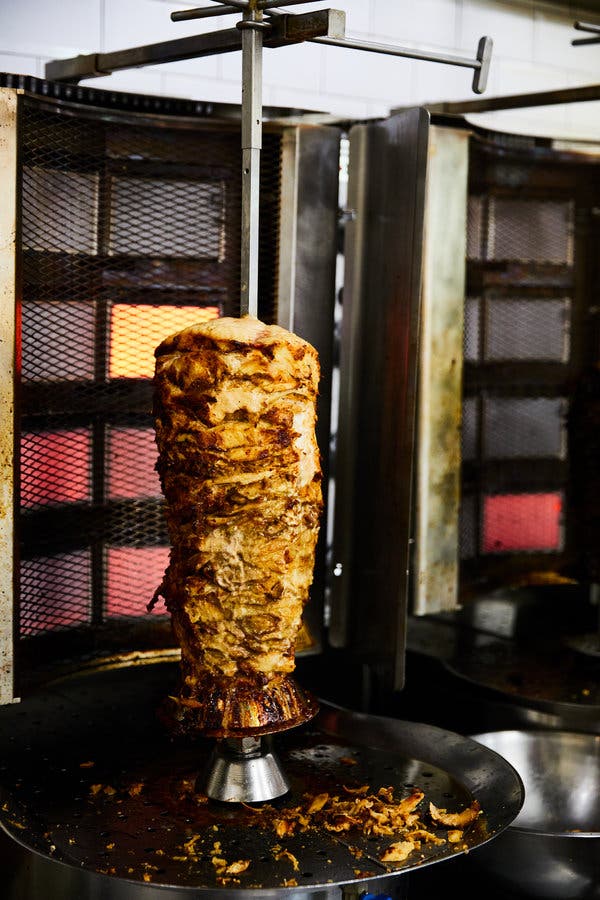Sakib, a restaurant in Williamsburg, Brooklyn, looks like the sort of place you would pop into for a takeout order of freshly shaved shawarma piled over yellow rice. But if you did that, you wouldn’t get to taste the assortment of dips, the crisp and meaty kibbe and the trays of puffy pies shaped like small pyramids, or open-faced boats that emerge from the kitchen’s imposing oven, imported from Jordan.
Diaa Alhanoun, the chef and an owner, makes the dough for the pies, or fatayer, himself. “Here, not too many people know about the pies,” he said, though different versions can be found throughout the city. Under Mr. Alhanoun’s care, they’re filled with lemony, spiced spinach, or brim with salty, fresh cheese. The leavened, olive oil-moistened dough is remarkably light and just sweet enough to be delicious on its own.
Mr. Alhanoun, 48, opened the restaurant with his business partner, Mohammad Ayasrah, 37, in July. Mr. Alhanoun, who is from Syria, has been cooking professionally since he was 15. In 2012, when the Syrian civil war was escalating, he was in Sudan opening a restaurant. It was not safe to return home, so Mr. Alhanoun moved to Jordan until he was accepted into the United States as a refugee with his wife and children.

Here, Mr. Alhanoun found familiar work in restaurants, and he eventually became a cook at Eat Offbeat, a catering company that hires professional cooks who are also refugees. “Diaa is a hard worker and honest person who was forced to leave his country,” said Mr. Ayasrah, who speaks English with more ease.
The menu at Sakib — named after Mr. Ayasrah’s hometown in Jordan — reads like an exhaustive listing of street food from the Levant, a historical area that includes countries like Syria, Lebanon and Jordan. Meat dominates, but some of the most rewarding dishes are rooted in the earth.
The msabaha is a soupy blend of chickpeas, sesame paste, lemon juice and oil (it shares the same ingredients as hummus, but the ratios are different), studded with whole cooked chickpeas for texture. Muhammara is dense with crushed walnuts, bread crumbs and glistens with olive oil. Hot sauce is the nontraditional secret to the tickling spice.
The falafel begin as a mealy mess of ground chickpeas, onion, garlic and parsley that is packed into a falafel scoop and tipped into hot oil. They turn dark and seemingly impenetrable, but split easily, and are contradictory in their lightness. Eaten alone or tucked into a wrap, the falafel at Sakib are worth seeking out.
After this parade of mezze, and the fluffy pita that goes with it, there is hardly a desire for the catalog of meats. But do order the kibbe. The shell of these oblong fritters is made with lean beef bound by finely ground bulgur wheat. The filling is yet more beef, fattier and juicier, sweetened with flecks of onion. Mr. Alhanoun’s kibbe are flawless, the result of years of repetition. (He was a wholesale supplier of kibbe in Syria.)
The décor at Sakib is an attempt at old-world charm, with faux stone and rounds of wood acting as stand-ins for centuries of Levantine history, but what really draws the eye are two vertical broilers for shawarma. Mr. Alhanoun threads strips of seasoned meat onto the skewers himself rather than buying prefabricated cones.
Chicken shawarma is lavished with garlic whip, and the cuttings from a spit of mixed lamb and beef are draped in silky tahini, called Arabic shawarma on the menu and which I preferred. The lamb was, in my opinion, better, its gamy drippings disguising even the beef. But on visits when the meats were trimmed to the core, I was better off ordering something else. The more reliable kefta kebab is ground lamb hand-pressed around iron skewers the length of an arm, then grilled until an alluring smoky char lingers.
Mr. Alhanoun was reticent when he talked about the conflict in Syria. But he was keen to bestow his hospitality, despite the topic of conversation, doling out tastes of sticky baklava or syrupy semolina cake on nearly every one of my visits. If you were only passing through, there’s so much that you would miss.
Follow NYT Food on Twitter and NYT Cooking on Instagram, Facebook, YouTube and Pinterest. Get regular updates from NYT Cooking, with recipe suggestions, cooking tips and shopping advice.




